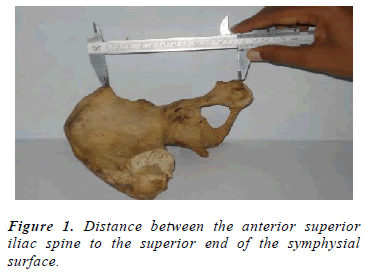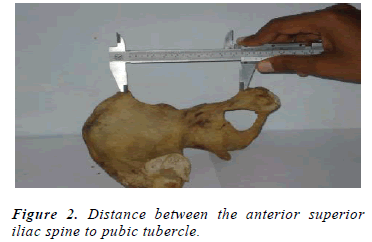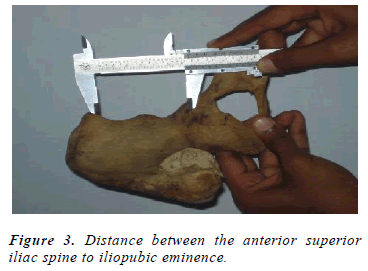ISSN: 0970-938X (Print) | 0976-1683 (Electronic)
Biomedical Research
An International Journal of Medical Sciences
- Biomedical Research (2012) Volume 23, Issue 2
Identification of the sex of human hip bone by metric analysis of its anterior border
Department of Anatomy, Shri B. M. Patil Medical College Hospital And Research Centre Bijapur, Karnataka, India.
Accepted Date: February 02 2012
Identification of sex of an individual from human skeletal remains is the first and arguably the most important step encountered by both forensic experts and archaeologists. The hip bone is considered as an ideal bone for sex determination as it provides the highest accuracy levels for sex determination. The present study was done with an aim to find out important measurements of anterior border that will significantly differentiate the sex of hip bone. For the study 65 hip bones(35 male and 30 female) of known sex are obtained from the department of Anatomy of BLDEA’s Shri B. M. Patil Medical College Hospital and Research centre Bijapur. Three parameters used were distance between the anterior superior iliac spine to the superior end of the symphysial surface, distance between the anterior superior iliac spine to pubic tubercle and distance between the anterior superior iliac spine to iliopubic eminence which were measured using Vernier caliper. In the present study significant statistical difference was seen in between the mean values of all the three parameters of male and female hip bones on the both the sides.
Keywords
Hip bone, anterior border, sex determination, parameters.
Introduction
Properly determining skeletal sex is a key element in any anthropological or forensic examination[1]. Therefore the study of sexual dimorphism of bones in human population is a matter of interest not only for the anatomist but also for the anthropologists and forensic experts [2]. Traditional non metrical methods such as visual impressions about the pattern of bone morphology for determination of sex from such skeletal remains depend entirely on the ability and experience of the expert and unless whole skeleton is available it is almost impossible to assign sex with hundred percent certainty in all cases. The introduction of precise measurement methods not only provides simplicity and accuracy but allows no individual variation and is therefore entirely an objective assessment [3]. Superiority of objective assessment by metrical methods over simple morphological observations has been well stressed [4].The hip bone is the most reliable indicator for the sex determination because of the pattern of sexual dimorphism is common to whole human race [5]. Hip bone is considered as an ideal bone for sex determination as it provides the highest accuracy levels for sex determination. Hence the hip bone is considered as the most reliable sex indicator in the human skeleton [6]. Many workers have studied various metric parameters for sexing the hip bone. The present study was done to identify the important measurements of the anterior border which significantly differentiates the sex of human hip bone which will be useful in anatomical, anthropological, archaeological and forensic studies.
Materials and Methods
For the study 65 hip bones(35 male and 30 female) of known sex collected in the Department of Anatomy of B.L.D.E.A’s Shri B. M. Patil Medical College Hospital and Research Centre, Bijapur were taken. The measurements of the anterior border of hip bone were measured by using instrument vernier calipers.
The various parameters measured were:
1. Distance between the anterior superior iliac spine to the superior end of the symphysial surface (Fig. 1).
2. Distance between the anterior superior iliac spine to pubic tubercle (Fig. 2).
3. Distance between the anterior superior iliac spine to iliopubic eminence (Fig. 3).
Inclusion Criteria
The adult human hip bones which were taken for study were fully ossified, not broken and not having any deformities.
Exclusion Criteria
The human hip bones excluded from the study were deformed bones, malunited bones and bones with congenital anomalies.
Results
All the 65 adult hip bones were measured using 3 parameters. After all the measurements were done, the observations were statistically analysed by using unpaired t- test. These male and female hip bones for both right and left sides were compared. The results are shown in tables 1-3 for all the variables used.
1. The distance between the anterior superior iliac spine to superior end of symphysial surface- The distance between the anterior superior iliac spine to superior end of symphysial surface in hip bone of male of right side varies from 11-13 cm with an average of 12.40±0.37 cm and that of female of right side varies from 11.1-13.1cm with an average of 11.77±0.29 cm. The hip bone of male of left side it varies from 11-13 cm with an average of 12.24±0.42 cm and that of female of left side it varies from 11-12.3 cm with an average of 11.71±0.23 cm. The sex differences in the mean values of distance between the anterior superior iliac spine to superior end of symphysial surface of hip bone of males and females is statistically significant (p<0.01) for both right and left hip bones.
2. The distance between the anterior superior iliac spine to pubic tubercle- The distance between the anterior superior iliac spine to pubic tubercle in hip bone of male of right side varies from 9.6-12 cm with an average of 10.94±0.49 cm and that of female of right side varies from 9.3-11.9 cm with an average of 10.10±0.46 cm. In hip bone of male of left side it varies from 9.6-12 cm with an average of 10.75±0.36 cm and that of female of left side it varies from 9.2-11.1 cm with an average of 9.80±0.37 cm. The sex differences in the mean values of distance between the anterior superior iliac spine to pubic tubercle of hip bone of males and females is statistically significant (p<0.01) for both right and left hip bones.
3. The distance between the anterior superior iliac spine to iliopubic eminence - The distance between the anterior superior iliac spine to iliopubic eminence in hip bone of male of right side it varies from 6.2-8.3 cm with an average of 7.4±0.54 cm and that of female of right side it varies from 5.2-7.9 cm with an average of 6.44±0.50 cm. In hip bone of male of left side it varies from 6.3-7.9 cm with an average of 7.13±0.28 cm and that of female of left side it varies from 5.6-7.4 cm with an average of 6.57±0.27 cm. The sex differences in the mean values of distance between the anterior superior iliac spine to iliopubic eminence of hip bone of males and females is statistically significant (p<0.01) for both right and left hip bones.
Discussion
1. Distance between the anterior superior iliac spine to superior end of symphysial surface
In the present study the mean value of the distance between the anterior superior iliac spine to the superior end of symphysial surface in the hip bones of right side the male hip bone is 12.40 cm and of female is 11.77 cm and on the left side it is 12.24 cm in males and 11.71 cm in female hip bones as compared to Pellico and Camacho[7] who found the mean value to be 13.59 cm in males and 13.13 cm in females.
2. Distance between the anterior superior iliac spine to pubic tubercle.
In the present study the mean value of the distance between the anterior superior iliac spine to pubic tubercle in hip bones of right side the male hip bone is 10.94 cm and of female is 10.10 cm and on the left side it is 10.75 cm in males and 9.80 cm in female hip bone as compared to Pellico and Camacho[7] who found the mean value to be 12.19 cm in males and 11.53cm in females.
3. Distance between anterior superior iliac spine to iliopubic eminence.
In the present study the mean value of the distance between anterior superior iliac spine to iliopubic eminence in the hip bone right side the male hip bones is 7.40 cm and of female is 6.44 cm and on the left side it is 7.13 cm in males and 6.57 cm in female hip bones as compared to Pellico and Camacho[7] who found the mean value to be 7.96 cm in males and 7.65 cm in females.
Conclusion
In the present study three parameters were used to measure the anterior border of hip bone. The parameters used were distance between the anterior superior iliac spine to the superior end of the symphysial surface, distance between the anterior superior iliac spine to pubic tubercle and distance between the anterior superior iliac spine to iliopubic eminence. After the statistical analysis of all the three parameters, significant statistical difference was seen in the mean values of these parameters of male and female hip bones on both the sides. Hence these parameters are useful in identifying the sex of the human hip bone by metric analysis of its anterior border.
References
- Dar G, Hershkovitz I. Sacroiliac joint bridging: simple and reliable criteria for sexing the skeleton. J Forensic Sci 2006; 51 (3): 480-483.
- Trancho GI, Robledo B, Bueis LI, Sanchez IA. Sexual determination of femur using discriminant functions : Analysis of a Spanish population of known sex and age. J Forensic Sci 1997; 42 (2):181-185.
- Singh G, Singh S, Singh SP. Identification of sex from tibia. J Anat Soc India 1975; 24: 20-24.
- Raju PB, Singh S. Sexual dimorphism in scapula. J Indian Acad Forensic sci 1978; 17 (2): 23-33.
- Bruzek J, Murail J . Methodology and reliability of sex determination from the skeleton. France : Humana Press; 2007.p.225-242.
- Nagesh KR, Kanchan T, Bastia BK. Sexual dimorphism of acetabulum? pubis index in South ? Indian population. Leg Med 2007; 9: 305-308.
- Pellico LG, Camacho FJ. Biometry of the anterior border of the human hip bone:normal values and their use in sex determination. J Anat 1992; 181: 417-422.





